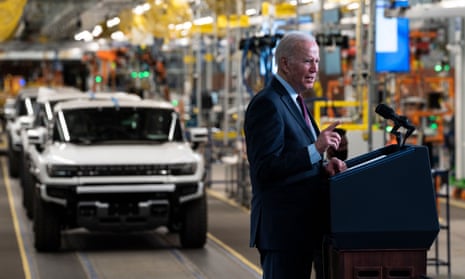The Biden administration has unveiled a plan to award nearly $5bn over five years to build thousands of electric vehicle charging stations.
The nationwide network of electric vehicle charging stations would place new or upgraded ones every 50 miles (80km) along interstate highways as part of the administration’s plan to spur widespread adoption of zero-emission cars.
Under Department of Transportation requirements, states must submit plans to the federal government and can begin construction this year if they focus first on highway routes, rather than neighborhoods and shopping centers, that can allow people to take their electric vehicles long distances.
Each station would need to have at least four fast-charger ports, which enable drivers to fully recharge their vehicles in about an hour.
Many technical details are to be worked out, and the administration acknowledges it will take work to persuade drivers accustomed to gas-powered cars, particularly in rural areas. The money is far less than the $15bn that Biden had envisioned to fulfill a campaign promise of 500,000 charging stations by 2030, and it may take substantial private investment to make the plan work.
“A century ago, America ushered in the modern automotive era; now America must lead the electric vehicle revolution,” the transportation secretary, Pete Buttigieg, said.
Buttigieg made the announcement in front of the transportation department along with White House officials, flanked by a pair of black Ford Mustang Mach-E SUVs in the federal government’s growing electric fleet that he and the energy secretary, Jennifer Granholm, drive. The vehicle’s retail price starts around $44,000 and climbs to $60,000-plus including options, and they are currently made in Mexico.
Buttigieg made a special appeal to rural drivers, suggesting that big wide open spaces of the US no longer need to be a “valley of death” for EV drivers.
“Many might think of them as a luxury item,” he said. “The reality is nobody benefits more from EVs in principle than those who drive the longest distances, often our rural Americans.”
The law provides an additional $2.5bn for local grants, planned for later this year, to fill remaining gaps in the charging network in rural areas and in disadvantaged communities, which currently are less likely to own the higher-priced electric vehicles. States failing to meet all the federal requirements risk delays in getting approval from the Federal Highway Administration or not getting money at all.
Biden also has set a goal of 50% electric vehicle sales by 2030, part of a broader effort to become zero emissions economy-wide by 2050.
Electric vehicles amounted to less than 3% of US new auto sales last year, but forecasters expect big increases in the next decade. Consumers bought about 400,000 fully electric vehicles.
Biden hopes to do even more to promote electric vehicles, including a provision in his stalled social and environmental bill for a $7,500 tax credit for people who buy electric vehicles.
“It’s going to help ensure that America leads the world on electric vehicles,” Biden said this week about American companies expanding EV infrastructure.
“China has been leading the race up to now, but this is about to change,” he said.
“Because America is building convenient, reliable, equitable national public charging networks. So wherever you live, charging an electric vehicle will be quick and easy.”
Granholm described the initial $5bn investment as creating “the spine” of the national network.
Jessika Trancik, a professor at the Massachusetts Institute of Technology who studies EV charging, called the administration’s approach a good first step. She said a successful strategy to spur wider EV use would require charging stations in a host of different locations, including faster charging along highways and slower charging near homes and workplaces.
